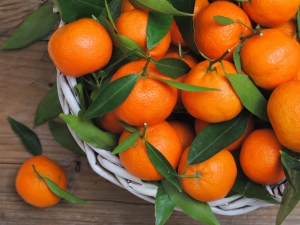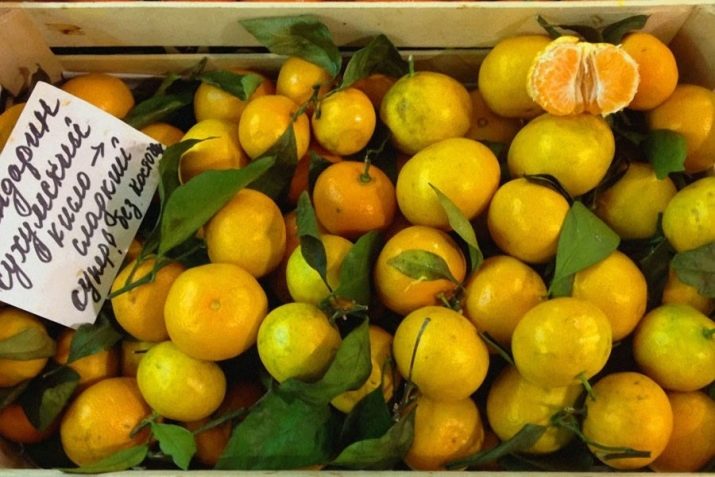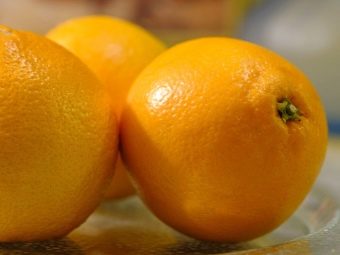Mandarins: places of growth, ripening season, differences and selection criteria

Mandarin is one of the most beloved tropical fruits by our compatriots, which is also popular because such a product is very affordable - fortunately, it is grown in many neighboring countries. However, besides the description of color and taste, our people know not so much about this fruit, and this situation should be corrected.
Homeland fruit
Erudite people will most likely remember that the main dialect of Chinese is called Mandarin, but their assumption is incorrect - modern scholars believe that India is the original homeland of the Mandarins. This fruit came to China two thousand years ago - it was his first “trip abroad”.
In those days, only the emperor could afford such imports, and only after several centuries with the establishment of stable trade relations could even indulge himself with this delicacy and just high-ranking officials, who were called for it mandarins, and the language they and the emperor himself spoke Mandarin. Although the climate of China allows, this wonderful fruit has become accessible here only in the Middle Ages.
The popularization of tangerines in China coincided with a sharp activation of travelers around the world, so this country has opened this wonderful fruit to the world. From here, tangerines were brought not only to neighboring Japan, but also to Europe, where they came in the form of single copies around the Middle Ages with the mediation of Arab and Turkish merchants, as well as the Crusaders.
The fruit came to taste to all the people who tried it, and it also turned out to be relatively resistant to cold, so it took root in relatively cold countries of the Mediterranean without any selection.
The word "greenhouse", by the way, is of French origin and implies a garden for oranges, that is, oranges, but in cool France of the Middle Ages, tangerines would rather have taken root - then there was no particular difference.
If we talk about the post-Soviet space, then the mandarins got through the territories that previously belonged to Ottoman Turkey, and then departed from the Russian Empire - this is Georgia. From there, they eventually spread to all Transcaucasia and even got to the southern coast of Crimea.
Today this fruit, perhaps, will not be called a wonder in any region of the world. Even in the northern countries, many grow this low (from one and a half meters) tree right in the apartment as a decoration with tasty bonuses.
Where grow and when ripen?
Tangerines are growing nowadays almost anywhere - it’s easier to name a country where they don’t exist. Interestingly, in the wild this plant has not survived, so that the culture is only domesticated. In private households, mandarins traditionally ripen in a season that is quite atypical for our region - from November to January. But selection and active care led to the fact that today these fruits are being sown almost year-round. You can eat them fresh even in May, even in October, or in February.
Tens of millions of tons of this tasty and healthy fruit are grown annually in the world. The undoubted leader in terms of production is China, where it comes from. In 2016, 17.3 million tons of such citrus fruits were raised, whereas in the second Spain that is underway, their production lags significantly behind - they were harvested "in total" 2.94 million tons. On the other hand, the top five countries that exceeded the 2016 harvest of one million tons, excluding China, are complemented exclusively by the countries of the Mediterranean region - Turkey (1.34 million tons), Morocco (1.08 million tons) and Egypt (1.02 million tons) ).
If we talk about the world as a whole, then actually these fruits are massively grown in any tropical country. Moreover, they are absolutely everywhere, but in the north their numbers simply do not count - the value is too small. Moreover, in each region there are local leaders who, perhaps, do not export their crops, but at least provide them with themselves. These leaders, in addition to those mentioned above, include the following:
- in South America - Brazil, Argentina and Peru;
- in Asia, Japan, Iran, South Korea, Pakistan, Thailand and Nepal;
- in Europe - Italy;
- in North America - the USA and Mexico;
- in Africa - Algeria.
In Russia, as in most other post-Soviet countries, with local mandarins it turns out rather badly - they grow more in theory rather than in practice, and this number does not even fall in the UN statistics. If you still want to try exactly the Russian mandarin, the easiest way to do this in the vicinity of Sochi - there this culture is valued rather highly. As for the shelves, then they tangerines come from other countries, for example, from the top five world production.
Many domestic stores offer relatively inexpensive Georgian mandarins due to good logistics (international statistics also include those grown in unrecognized Abkhazia) - 60,000 tons were grown in 2016, but this is enough for export to almost the entire post-Soviet space. From other countries of the region, only Azerbaijan (39 thousand tons) and Uzbekistan (1.6 thousand tons) can boast of relatively significant production.
Properties and taste
The taste of tangerine is familiar to everyone - this pleasant citrus has pronounced sweet notes that are not present in an orange. It should be noted that there are two separate varieties of this fruit, which are very popular in the world - tangerine and clementine. Tangerine, named after the Moroccan city of Tangier, is actually grown mainly in China, where it is considered even more common than its “standard” counterpart.
Such a fruit, according to the description, does not differ from ordinary mandarin except for a more red color. We often call Clementine a Moroccan mandarin, and it really comes mostly from this country, but it is distinguished by increased sweetness and lack of seeds with a somewhat complicated cleaning.
Mandarin is one of those delicacies that you should not deny yourself, although excessive use, of course, also will only harm. By its own taste and smell, such a fruit can significantly raise the spirits, but its benefits do not end there - it contains many useful substances, among which relatively rare ones are especially valuable.
These include choline, for example - it can be obtained either from mandarins or from egg yolk, and there are no other publicly available sources. This substance is absolutely indispensable during pregnancy, because scientists have proven that its deficiency can more than double the risk of the appearance of congenital malformations. It is not surprising, because choline is actively involved in the development of the brain, and even neutralizes some of the unpleasant consequences of diseases of the cardiovascular system, including inflammatory processes.
Two more substances - lutein and zeaxanthin - work in pairs in order to improve vision. They are generally responsible for the good sensitivity of nerve endings in the eyes, but, in addition, they also protect the visual apparatus from the destructive effects of ultraviolet radiation.
Contrary to popular belief, we get the main dose of light from the blue part of the spectrum, which is ultraviolet, not from space, even in view of the growing ozone holes, namely due to the active use of computers and other similar equipment.
Practically the only available alternative for mandarins as a source of lutein and in this case is egg yolk.
If we talk about vitamins, then most of all here are the B vitamins that support absolutely all systems of the body, as well as C - the famous ascorbic acid, so necessary for strengthening the immune system. It should be noted and the presence of vitamin K, without which the vascular walls would not be so elastic.In tangerines there is also a complex of trace elements, including calcium and iron, magnesium and sodium, phosphorus and potassium.
If we talk about the complex effect of mandarins on the human body, it is impossible not to note their extremely positive effect in improving appetite, as well as accelerating the metabolism and excretion of toxins. As befits a citrus, and even spicing in the winter, mandarin is an incredibly effective remedy for the characteristic of beriberi, and with regular use can be a worthy prevention of various colds.
Recently, theories have also been studied, according to which the juice of this fruit can prevent the development of certain skin diseases.
What is different and how to choose?
A very large range of growth of mandarins a priori implies certain differences between regional variants, so you can get an idea about the fruit just because of where it grew. There is a certain risk of running into a discrepancy with expectations, but usually it is small, so it is worth considering sound stereotypes.
- From Turkey bring the cheapest fruits - this is possible due to large volumes of deliveries. Honestly, for such a product to ask for a high cost and not worth it, because the Turks obviously put on the quantity, not the quality. Their fruits are distinguished by a sour taste, the presence of several bones in each specimen and a firmly adhering sandpaper.
- Abkhazian or generally Georgian mandarins It is not difficult to meet - it is this region that supplies the main volume of this product to our country. This product can be attributed to the goods of average quality - the bones are still a lot, but the taste is already less sour, and the skin is removed much easier than the Turkish competitors. You can also distinguish such a fruit by an unusually yellow skin.
- Moroccan Clementines are not mandarins in the full sense - it is rather their hybrid with one of the varieties of orange. The product is characterized by a rich orange color of dark shades, the skin is removed very easily, and in the pulp there are no bones or any significant sourness.
- Spanish tangerines - this is an elite product, you can rarely meet it, and you will have to pay quite expensive. This fruit is not devoid of several seeds, but it is extremely easy to clean, and most importantly, it has an atypical, extremely sweet taste without any hint of sourness.
- Chinese Tangerines for the majority of our fellow citizens are exotic, but in areas directly bordering China, such fruit is not so difficult to get. Its shape is unusual - it looks more like a pumpkin. Seeds here are few, and the taste can be described as sweet and sour.
As for freshness, here the choice is extremely simple - for tangerines it is clearly noticeable if they are spoiled. A good fruit should have a smooth skin without any dents or mold marks, not to mention rot stains. A truly ripe fruit necessarily has a high juice content. It is enough to squeeze it a little in your hand so that it sprinkles the fragrant liquid. In this case, a certain discount must be done also for the season. For example, in the midst of winter sweet Israeli tangerines are often brought to us, which, even in ripe juice, are not particularly sprinkled because they are dry in principle.
How to grow tangerine at home, see the next video.

































